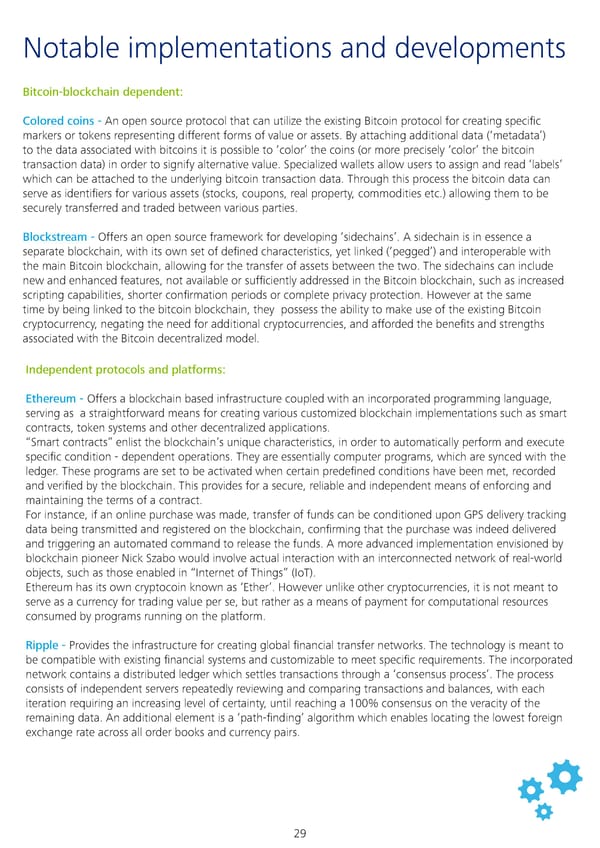Notable implementations and developments Bitcoin-blockchain dependent: Colored coins - An open source protocol that can utilize the existing Bitcoin protocol for creating specific markers or tokens representing different forms of value or assets. By attaching additional data (‘metadata’) to the data associated with bitcoins it is possible to ‘color’ the coins (or more precisely ‘color’ the bitcoin transaction data) in order to signify alternative value. Specialized wallets allow users to assign and read ‘labels’ which can be attached to the underlying bitcoin transaction data. Through this process the bitcoin data can serve as identifiers for various assets (stocks, coupons, real property, commodities etc.) allowing them to be securely transferred and traded between various parties. Blockstream - Offers an open source framework for developing ‘sidechains’. A sidechain is in essence a separate blockchain, with its own set of defined characteristics, yet linked (‘pegged’) and interoperable with the main Bitcoin blockchain, allowing for the transfer of assets between the two. The sidechains can include new and enhanced features, not available or sufficiently addressed in the Bitcoin blockchain, such as increased scripting capabilities, shorter confirmation periods or complete privacy protection. However at the same time by being linked to the bitcoin blockchain, they possess the ability to make use of the existing Bitcoin cryptocurrency, negating the need for additional cryptocurrencies, and afforded the benefits and strengths associated with the Bitcoin decentralized model. Independent protocols and platforms: Ethereum - Offers a blockchain based infrastructure coupled with an incorporated programming language, serving as a straightforward means for creating various customized blockchain implementations such as smart contracts, token systems and other decentralized applications. “Smart contracts” enlist the blockchain’s unique characteristics, in order to automatically perform and execute specific condition - dependent operations. They are essentially computer programs, which are synced with the ledger. These programs are set to be activated when certain predefined conditions have been met, recorded and verified by the blockchain. This provides for a secure, reliable and independent means of enforcing and maintaining the terms of a contract. For instance, if an online purchase was made, transfer of funds can be conditioned upon GPS delivery tracking data being transmitted and registered on the blockchain, confirming that the purchase was indeed delivered and triggering an automated command to release the funds. A more advanced implementation envisioned by blockchain pioneer Nick Szabo would involve actual interaction with an interconnected network of real-world objects, such as those enabled in “Internet of Things” (IoT). Ethereum has its own cryptocoin known as ‘Ether’. However unlike other cryptocurrencies, it is not meant to serve as a currency for trading value per se, but rather as a means of payment for computational resources consumed by programs running on the platform. Ripple - Provides the infrastructure for creating global financial transfer networks. The technology is meant to be compatible with existing financial systems and customizable to meet specific requirements. The incorporated network contains a distributed ledger which settles transactions through a ‘consensus process’. The process consists of independent servers repeatedly reviewing and comparing transactions and balances, with each iteration requiring an increasing level of certainty, until reaching a 100% consensus on the veracity of the remaining data. An additional element is a ‘path-finding’ algorithm which enables locating the lowest foreign exchange rate across all order books and currency pairs. 29
 Israel: A Hotspot for Blockchain Innovation Page 33 Page 35
Israel: A Hotspot for Blockchain Innovation Page 33 Page 35